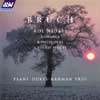Bruch Chamber Works
Sympathetic performances of works from early and late in Bruch’s career
View record and artist detailsRecord and Artist Details
Composer or Director: Max Bruch
Genre:
Chamber
Label: ASV
Magazine Review Date: 12/2002
Media Format: CD or Download
Media Runtime: 75
Mastering:
Stereo
DDD
Catalogue Number: CDDCA1133

Tracks:
| Composition | Artist Credit |
|---|---|
| Kol Nidrei |
Max Bruch, Composer
Max Bruch, Composer Philip Dukes, Viola Sophia Rahman, Piano |
| Romance |
Max Bruch, Composer
Max Bruch, Composer Philip Dukes, Viola Sophia Rahman, Piano |
| (6) Pieces |
Max Bruch, Composer
Max Bruch, Composer Sophia Rahman, Piano |
| (8) Pieces |
Max Bruch, Composer
Max Bruch, Composer Philip Dukes, Viola Robert Plane, Clarinet Sophia Rahman, Piano |
Author: John Warrack
In his valuable study, Max Bruch (Gollancz: 1988), Christopher Fifield quotes the old composer as saying in 1906: ‘A young Spanish cellist called Pablo Casals has had exceptional success with my Kol Nidrei.’ He could have heard Casals’ 1915 recording, which remains in the catalogue to this day, though he seems not to have cared for the new-fangled device of the gramophone (‘a machine!!!’).
It remains one of his most-recorded works, generally for violin or cello with either piano or orchestra, but Bruch was fairly free with allowing or even encouraging different instruments to play some of his works. Kol Nidrei certainly suits the viola, especially in this powerfully eloquent performance by Philip Dukes. For the Op 83 pieces Bruch also permitted various instrumental combinations, though clarinet, viola and piano work as well together here as they did in Mozart’s Kegelstatt Trio (K498), even if the music is less ambitious. He seems to have had a harp in mind at one time, and some of the piano writing suggests that. He also thought that they were better played as individual items rather than as a set, and agreeable as they are, they do not really make a complete work.
Nor do the six Op 12 pieces, which Sophia Rahman plays touchingly and with a nice understanding of their nature and their debt to Mendelssohn or Schumann. Certainly one or two of them – the touching grazioso waltz, for instance – would make an occasional encore piece.
It remains one of his most-recorded works, generally for violin or cello with either piano or orchestra, but Bruch was fairly free with allowing or even encouraging different instruments to play some of his works. Kol Nidrei certainly suits the viola, especially in this powerfully eloquent performance by Philip Dukes. For the Op 83 pieces Bruch also permitted various instrumental combinations, though clarinet, viola and piano work as well together here as they did in Mozart’s Kegelstatt Trio (K498), even if the music is less ambitious. He seems to have had a harp in mind at one time, and some of the piano writing suggests that. He also thought that they were better played as individual items rather than as a set, and agreeable as they are, they do not really make a complete work.
Nor do the six Op 12 pieces, which Sophia Rahman plays touchingly and with a nice understanding of their nature and their debt to Mendelssohn or Schumann. Certainly one or two of them – the touching grazioso waltz, for instance – would make an occasional encore piece.
Discover the world's largest classical music catalogue with Presto Music.

Gramophone Digital Club
- Digital Edition
- Digital Archive
- Reviews Database
- Full website access
From £8.75 / month
Subscribe
Gramophone Full Club
- Print Edition
- Digital Edition
- Digital Archive
- Reviews Database
- Full website access
From £11.00 / month
Subscribe
If you are a library, university or other organisation that would be interested in an institutional subscription to Gramophone please click here for further information.




